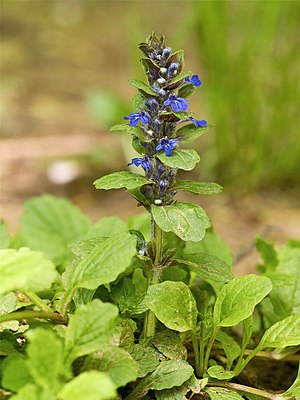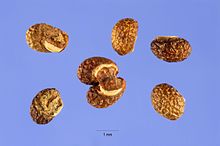Creeping Gunsel
| Creeping Gunsel | ||||||||||||
|---|---|---|---|---|---|---|---|---|---|---|---|---|

Creeping Gunsel ( Ajuga reptans ) |
||||||||||||
| Systematics | ||||||||||||
|
||||||||||||
| Scientific name | ||||||||||||
| Ajuga reptans | ||||||||||||
| L. |
The crawling Günsel ( Ajuga reptans ) is a plant of the genus Ajuga ( Ajuga ) within the family of Labiatae (Lamiaceae).
description


Vegetative characteristics
The creeping günsel is a perennial herbaceous plant that reaches heights of 10 to 30 cm. It has a short, strong rhizome and long runners that take root at the nodes. The mostly upright stem is square, reddish-purple at the bottom and hairy all around in the upper area.
The leaves are arranged in basal rosettes and arranged opposite on the stem. The stalked leaves are ovate-spatulate and shiny on top.
Generative characteristics
The flowering period extends from April to June, and individual plant specimens rarely bloom even later. Three to six inflorescences are arranged in lateral pseudo whorls. The bracts are simple.
The hermaphrodite flowers are zygomorphic and five-fold with a double flower envelope . The flower crowns are usually colored blue with lighter stripes, less often pink or white (albino). A special feature of the 1 to 1.5 centimeter long corollas is the apparently missing, but actually tiny upper lip.
Typically for the mint, four-part Klausen fruits are formed, which disintegrate into four solitary partial fruits (= broken fruit ).
The number of chromosomes is 2n = 32.
Occurrence
The main distribution area of Ajuga reptans extends from Europe and North Africa to the Caucasus and Iran . In North America the species is a neophyte .
The creeping Günsel thrives on fresh, nutrient-rich, neutral to moderately acidic, humus-rich clay soils in meadows, in deciduous forests, on the edges of forests, under hedges and in gardens. In Central Europe it often grows in Arrhenatheretalia societies, but also in Fagetalia societies. It is a nutrient and freshness indicator and a light to partial shade plant. In the Alps it occurs at altitudes of around 2000 meters. In the Allgäu Alps, it rises on the southwest ridge of the Diedamskopf in Vorarlberg to an altitude of up to 1,800 meters.
ingredients
Important ingredients are tannins .
use
Use as an ornamental plant
Creeping Günsel is also used as a ground cover under light shrubs and trees, especially the variant with shiny metallic dark red leaves. Due to the long runners, it often grows into the lawn and is then mostly considered a weed . There are also cultivated forms that z. T. have spotted foliage or should be less willing to spread.
Use as a medicinal plant
An infusion of dried flowering parts of the plants of the creeping gun is said to help against rheumatism , stomach ulcers , angina and diarrhea , and used externally against skin inflammation , hemorrhoids and inflammation of the mucous membranes .
Common names
Other common names for the crawling Günsel are or were, in some cases only regionally: Apple leaves (Ens), Bilibluama ( St. Gallen near Chaster), Bimu ( Middle High German ), Blawellen ( Zillertal near Fügen ), Braunellen (Zillertal near Fügen), Buggeln ( Bern ), Consel (Middle High German), Cunseln (Middle High German), gülden Günsel, gulden Güntzel (Middle High German), blue Gukguk ( Altmark , Silesia ), Gunsel (already Middle High German), Guntzel, Gutzegagel, Heilkräutlein ( Swabia ), Hundzung (Middle High German) , St. Kathrinamaja (St. Gallen near Sargans ), Kriechgünsel, Lorenzkraut (Silesia), blow Meyblume, Melcherdözen ( Salzburg Alps), Melcherstözen, Riesli ( Toggenburg ), Sappenkraut, Steinünsel, Wiesengünsel ( Switzerland ), meadow herbs, Wisskrut (Middle High German) , Wundkrut (Middle High German), Wundecrut (Middle High German), Wuntcrut (Middle High German) and Zapfenkraut (Silesia).
history
Grimm's dictionary gives the following explanation for "Günsel":
- “Gunsel, günsel, also gunzel, günzel, a medicinal herb, Ajuga reptans. From Middle Latin, Latin consolida, which is derived from consolidare 'to fix' and denotes the force that is ascribed to this plant. "
From the 13th to the 16th century, the following medicinal plants, among others, were called consolida (Latin; "Festmacherin"), although an exact classification is not always possible:
- Small brown aliases , forest sanicles and daisies ( Consolida minor ).
- Creeping Gunsel ( Consolida media , Consolida aurea , Consolida mediocris ).
- Common comfrey (Symphytum officinale) and round-leaved wintergreen ( Consolida , Consolida maior ).
- Common barbarian spur ( Consolida regalis ).
The crawling Günsel was referred to in Alsace manuscripts as "small guntzel" in the first half of the 15th century:
“Guntzel waſſer the little one eats well for the dermen. And the sore ring. Vnd iſt drunk well ſo one geuellet ſo no blood coagulates in ime. Vnd eats well for dz eſſen in the mouth dz one wechet it in the middle. "
Hieronymus Brunschwig also included these indications in his Kleines Distillierbuch and called the creeping Günsel "güldin gunsel". From the small distilling book, the descriptions of the creeping Günsels found their way into the herbal books of the fathers of botany ( Otto Brunfels , Hieronymus Bock and Leonhart Fuchs ). They believed they recognized the Creeping Gunsel in the "chamaipitys" of Dioscurides .
Historical illustrations
Vitus outlet 1479
Garden of Health 1485
Otto Brunfels 1532
Leonhart Fuchs 1543
Hieronymus Bock 1546
literature
- Gunter Steinbach (Ed.), Bruno P. Kremer u. a .: wildflowers. Recognize & determine. Mosaik, Munich 2001, ISBN 3-576-11456-4 .
- Manfred A. Fischer, Wolfgang Adler, Karl Oswald: Excursion flora for Austria, Liechtenstein and South Tyrol . 2nd, improved and enlarged edition. State of Upper Austria, Biology Center of the Upper Austrian State Museums, Linz 2005, ISBN 3-85474-140-5 .
- Erich Oberdorfer : Plant-sociological excursion flora for Germany and neighboring areas . With the collaboration of Angelika Schwabe and Theo Müller. 8th, heavily revised and expanded edition. Eugen Ulmer, Stuttgart (Hohenheim) 2001, ISBN 3-8001-3131-5 .
- Walter Erhardt , Erich Götz, Nils Bödeker, Siegmund Seybold: The great pikeperch. Encyclopedia of Plant Names. Volume 2. Types and varieties. Eugen Ulmer, Stuttgart 2008, ISBN 978-3-8001-5406-7 .
Individual evidence
- ↑ Rafaël Govaerts (ed.): Ajuga reptans. In: World Checklist of Selected Plant Families (WCSP) - The Board of Trustees of the Royal Botanic Gardens, Kew . Retrieved September 7, 2019.
- ↑ ISBN 3-8001-3131-5 Erich Oberdorfer : Plant-sociological excursion flora for Germany and neighboring areas . With the collaboration of Angelika Schwabe and Theo Müller. 8th, heavily revised and expanded edition. Eugen Ulmer, Stuttgart (Hohenheim) 2001, ISBN 3-8001-3131-5 , pp. 794 .
- ↑ Erhard Dörr, Wolfgang Lippert : Flora of the Allgäu and its surroundings. Volume 2, IHW, Eching 2004, ISBN 3-930167-61-1 , p. 387.
- ^ The Royal Horticultural Society - Dumont's Great Plant Encyclopedia, Volume I: AJ . Published by Christopher Brickell, editor of the German edition Wilhelm Barthlett, Botanical Institute of the University of Bonn. Edited and translated from English by Nadja Biedinger and Rüdiger Seine. 1998, ISBN 3-7701-4350-7 , pp. 92 .
- ↑ The Great Encyclopedia of Medicinal Plants - Their Use and Their Natural Healing Power . Translation from Italian by Walter Wurzer. 1994, ISBN 3-7043-9002-X , pp. 57 .
- ^ Georg August Pritzel , Carl Jessen : The German folk names of plants. New contribution to the German linguistic treasure. Philipp Cohen, Hannover 1882, p. 14, online.
- ↑ Heinrich Marzell : Dictionary of German plant names. 5 volumes, Leipzig, from volume 3 Stuttgart / Wiesbaden, volume 1, p. 168.
- ↑ Grimm: günsel (digitized version )
- ↑ Barbara Fehringer: The "Speyer herb book" with the medicinal plants of Hildegard von Bingen. A study on the Middle High German “Physica” reception with a critical edition of the text. Würzburg 1994 (= Würzburg Medical History Research , Supplement 2), p. 100 and 103
- ^ Gart der Gesundheit (1485), Chapter CXLVIII.
- ↑ Adam Lonitzer : Kreuterbuch. Artificial conterfeytunge of trees, shrubs, hedges, herbs, grain, Gewuertze [...]. Edited by Peter Uffenbach, (Frankfurt am Main 1557, further edition there 1630; last edition Augsburg 1783) Ulm an der Donau 1679; Reprint (Leipzig 1934 and by) Konrad Kölbl, (Grünwald near) Munich 1962, p. 450.
- ↑ Hermann Fischer : Medieval botany. Munich 1929 (= history of science: history of botany , 2), p. 262
- ↑ Otto Zekert (Ed.): Dispensatorium pro pharmacopoeis Viennensibus in Austria 1570. Berlin 1938, p. 140
- ↑ Walther Ryff : Confect Büchlin and Hausz Apoteck. Frankfurt am Main 1544, p. 7
- ^ Adam Lonitzer : Kreuterbuch ... (Frankfurt am Main 1557), ed. by Peter Uffenbach, Ulm an der Donau 1679, p. 330 f.
- ↑ Hieronymus Brunschwig: The book of the Cirurgia. Strasbourg 1497, sheet 126
- ^ Johann Wonnecke von Kaub : Hortus sanitatis German. Peter Schöffer, Mainz 1485, chap. XCVI
- ↑ The sore bowels
- ↑ For sore oral mucosa
- ↑ Frankfurt, MS. germ. qu. 17, Alsace, 1st quarter of the 15th century, sheet 344ra (digital copy ) ; also abridged in Heidelberg, Cpg 638, Alsace / Basel, 2nd quarter of the 15th century. Sheet 24v (digitized version )
- ↑ Hieronymus Brunschwig . Small distilling book . Strasbourg 1500, sheet 52r (digitized version )
- ^ Otto Brunfels : Contrafeyt Kreüterbuch. Strasbourg 1532, p. 191 (digitized version) ; Hieronymus Bock : New Kreütter book. Strasbourg 1539, book I, cap. 103 (digitized version) ; Leonhart Fuchs : New Kreütterbuch. Strasbourg 1543, Cap. 147 (digitized version)
- ↑ De materia medica , Book III, Chapter 165, 166 (digitized version)
Web links
- Ajuga reptans L., Kriech-Günsel. In: FloraWeb.de.
- Profile and distribution map for Bavaria . In: Botanical Information Hub of Bavaria .
- Creeping Gunsel . In: BiolFlor, the database of biological-ecological characteristics of the flora of Germany.
- Ajuga reptans L. In: Info Flora , the national data and information center for Swiss flora .
- Distribution in the northern hemisphere from: Eric Hultén, Magnus Fries: Atlas of North European vascular plants. 1986, ISBN 3-87429-263-0 at Den virtuella floran. (swed.)
- Thomas Meyer: Günsel data sheet with identification key and photos at Flora-de: Flora von Deutschland (old name of the website: Flowers in Swabia ).
- Carl von Linné: Species Plantarum. Volume 2, Lars Salvius, Stockholm 1753, p. 561 (first description).
- Literature on Ajuga reptans in the Kew Bibliographic Databases . (English)







